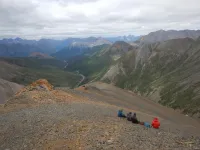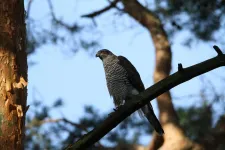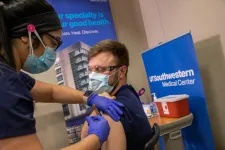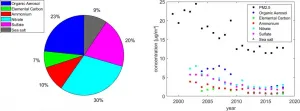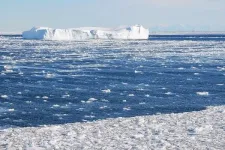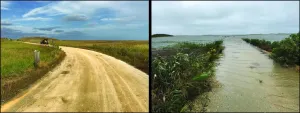UMD develops technology allowing researchers to image wetland soil activity in real time
Imaging allows for the calculation of iron reduction rates, providing a deeper understanding of wetland soil behavior
2021-03-23
(Press-News.org) Featured on the cover of the Soil Science Society of America Journal, researchers at the University of Maryland (UMD) and the Spanish National Research Council partnered to create a new camera allowing for the imaging of wetland soil activity in real time. This camera gives the classic IRIS (indicator of reduction in soils) technology a big upgrade. IRIS is used universally by researchers and soil assessors to determine if soils are behaving like wetland soils and should therefore be classified as such. However, before this new camera, soil assessors couldn't quantify the rate of iron reduction in saturated wetland soils, and researchers had no way to visualize the process in real time. This technology opens up new research avenues in soil science, and gives a compelling peak at how biochemically active wetland soils really are.
"The interest in this paper has been really amazing, although it wasn't initially why I created the camera," says Brian Scott, doctoral candidate in Environmental Science and Technology at UMD. "The paper shows that this camera really works, but what interested people was the real time imaging and rates of iron reduction in wetland soils. But to be honest, the real reason I did it wasn't for the practical reason of calculating rates. It was more about trying to explore ways to visualize what's happening in the environment. I study soils, and everything is underground. So I developed this method to look at what is actually happening under the surface, which is really exciting to me."
"There are three major parameters needed to classify an area as a wetland: hydrology or water, the plant community, and soil properties," adds Martin Rabenhorst, esteemed soil scientist, professor in Environmental Science and Technology at UMD, and co-author on this paper. "These are all critical because wetlands are highly regulated and protected ecosystems. The soil is perhaps the most complicated piece of the puzzle because you have to confirm that certain biogeochemical processes are actually happening below ground where they are not easily seen."
Rabenhorst himself is an inventor of a greener method of IRIS, a technology used to measure the amount of iron reduction occurring in soils. The technology uses iron-oxide coatings on plastic tubes or films that are pushed into the soil and left for 30 days so the soil can react with the paint. As these reactions occur, the paint is partially dissolved from the tube. If 30 percent or more of the paint is stripped off, the soil is behaving like typical wetland soil.
"This is really because of the biochemistry of microorganisms in the soil," explains Scott. "The organisms I study breathe iron the same way we breathe oxygen. These microorganisms are anaerobic because they thrive in environments without oxygen and need the iron to respire. Oxygen is toxic to them, so they live in wetlands where the soil is often saturated with water and less oxygen rich. These organisms are so prevalent in wetland soils that they are the basis for our testing to see if a soil is hydric. IRIS testing has therefore become a focal point for biogeochemists that study wetlands."
While this technology has the potential to lead scientists down all sorts of new research avenues, it is unclear whether it might lead to improvements down the road for the typical soil assessor using classic IRIS technology.
But as Scott describes it, the real findings of the paper come in the methods used to create this camera, which he says is now reproducible by anyone for about $100. He converted a borescope camera used by plumbers and other industry professionals to image down pipes, and coupled that with a wireless system sending information in real time with just a small solar panel to see what is happening 24-7. "Some of the things that are the most important for this paper weren't really the findings; it was the process of development that opens up new applications and research avenues which is really exciting," says Scott.
The idea came to Scott while he was volunteering in Osvaldo Sala's lab at Arizona State University using a machine called a mini rhizotron that is used to count tree roots with a camera through a hollow tube in the ground. Scott thought, "If we can take pictures of roots, we should be able to take pictures of other things underground." So eventually, when Scott came to Maryland to pursue his PhD and started working with Rabenhorst, things all fell into place. The process, however, was not without its challenges.
"Once somebody has gone through this whole long process of how to make something work, then we can do it again and again easily, but it takes a long time to figure it out," says Scott. "It took a long time to figure out how to make this camera work, and I ran into roadblocks where I almost quit if it weren't for other people's input and ideas."
Scott particularly calls out a few people along the way that helped keep this process moving. An undergraduate assistant, Kristin Webb, helped sketch out the initial designs for the camera. Another undergraduate in Environmental Science and Technology and recent graduate, William Jacob Mast, helped design and print the camera shell using a 3-D printer. And Spanish collaborators at the Spanish National Research Council had a similar idea simultaneously and helped find ways to convert the video imagery into flat images that could be analyzed.
Scott stresses the importance of collaborative science throughout this process, and wants to make this technology available to others so that it can advance science and ultimately environmental health. "I'm not interested in patenting this particular technology because I want the science to benefit everyone," explains Scott. "It's not about money with this, it's about the impact for the environment. I spent my own money actually to help make sure that this could get built along with the support of the department, and I think that if it works, and if it helps another scientist make some even greater discovery, then that's worth it. It's about helping the world we live in."
Scott is pleased to be able to contribute to soil science and focus on the restoration of critical ecosystems like wetlands. "I was an environmental engineer for years, so I have an interest in taking care of the environment, and a lot of what environmental engineers do is clean up messes," says Scott. "Everything I do now is related to ecosystem recovery and restoration. I used to clean up messes, but it's a different animal to actually take ecosystems back to their former glory and restore their ecological functioning."
INFORMATION:
This paper, entitled "Macro and Microscopic Visual Imaging Tools to Investigate Metal Reducing Bacteria in Soils," is published in the Soil Science Society of America Journal, DOI: 10.1002/saj2.20092.
ELSE PRESS RELEASES FROM THIS DATE:
2021-03-23
BOSTON - An analysis of sex differences in the genetics of schizophrenia, bipolar disorder and major depressive disorders indicates that while there is substantial genetic overlap between males and females, there are noticeable sex-dependent differences in how genes related to the central nervous system, immune system, and blood vessels affect people with these disorders.
The findings, from a multinational consortium of psychiatric researchers including investigators and a senior author at Massachusetts General Hospital (MGH), could spur better treatments for major psychiatric disorders. They are published in the journal Biological Psychiatry.
The findings were made possible only through the cooperation of more than 100 investigators and research groups, ...
2021-03-23
A new technique that can trace which tissues and organs the DNA in our blood comes from has been reported today in the open-access eLife journal.
The method, called GETMap, could be used in prenatal screening, to monitor organ transplant rejection, or test for cancers that are concealed in the body.
"Analysis of circulating free DNA has been shown to be useful for screening for early asymptomatic cancers," explains first author Wanxia Gai, Postdoctoral Fellow at the Chinese University of Hong Kong, Hong Kong SAR, China. "As cancer-associated DNA changes are present in ...
2021-03-23
In a letter to The New England Journal of Medicine, published online March 23, 2021, a group of investigators from University of California San Diego School of Medicine and the David Geffen School of Medicine at UCLA report COVID-19 infection rates for a cohort of health care workers previously vaccinated for the novel coronavirus.
"Because of the compulsory daily symptom screening of health care personnel, patients, and visitors, and the high testing capacity at both UC San Diego Health and UCLA Health, we were able to identify symptomatic and asymptomatic infections among health care workers at our institutions," said co-author ...
2021-03-23
Boulder, Colo., USA: When geobiology graduate student Katie Maloney trekked into the mountains of Canada's remote Yukon territory, she was hoping to find microscopic fossils of early life. Even with detailed field plans, the odds of finding just the right rocks were low. Far from leaving empty-handed, though, she hiked back out with some of the most significant fossils for the time period.
Eukaryotic life (cells with a DNA-containing nucleus) evolved over two billion years ago, with photosynthetic algae dominating the playing field for hundreds of millions of years as oxygen accumulated in the Earth's atmosphere. Geobiologists think that algae evolved first in freshwater environments ...
2021-03-23
Over the past decades, the increased use of chemicals in many areas led to environmental pollution - of water, soil and also wildlife. In addition to plant protection substances and human and veterinary medical drugs, rodenticides have had toxic effects on wildlife. A new scientific investigation from scientists of the Leibniz Institute for Zoo and Wildlife Research (Leibniz-IZW), the Julius Kühn Institute (JKI) and the German Environment Agency (Umweltbundesamt - UBA) demonstrate that these substances are widely found in liver tissues of birds of prey from Germany. Anticoagulant rodenticides, commonly used to kill rodents in agriculture and forestry, were frequently detected, particularly in birds of prey close to or in urban environments. ...
2021-03-23
DALLAS - March 23, 2021 - Vaccinating health care workers resulted in an immediate and notable reduction of positive COVID-19 cases among employees, reducing the number of required isolations and quarantines by more than 90 percent, according to data at UT Southwestern Medical Center published in the New England Journal of Medicine.
Health care workers were among the first groups to be eligible for vaccination.
"Real-world experience with SARS-CoV-2 vaccination at UT Southwestern demonstrated a marked reduction in the incidence of infections among our employees, preserving the workforce when it was most needed," notes Daniel K. Podolsky, M.D., president of UT Southwestern and senior author.
During ...
2021-03-23
ITHACA, N.Y. - New research from Mildred Warner, professor of city and regional planning at Cornell University, shows that state laws designed to hinder union activity and indulge corporate entities do not enhance economic productivity.
"We find that where state policy is captured by corporate interests, this undermines inclusive growth," Warner said. "These interests see union and city power as a threat, which is why there are groups like the American Legislative Exchange Council, for example, focused on crafting state laws that erode labor protections and enhance corporate interests."
The ...
2021-03-23
California's restrictions on vehicle emissions have been so effective that in at least one urban area, Los Angeles, the most concerning source of dangerous aerosol pollution may well be trees and other green plants, according to a new study by University of California, Berkeley, chemists.
Aerosols -- particles of hydrocarbons referred to as PM2.5 because they are smaller than 2.5 microns in diameter and easily lodge in the lungs -- are proven to cause cardiovascular and respiratory problems.
As a result of strict vehicle emissions laws, organic aerosol levels have been significantly reduced throughout the United States, but the drop has been particularly dramatic ...
2021-03-23
Understanding the evolution of the polar sea ice is not enough to study the effects of the climate change on marine ecosystems in Antarctic seafloors. It is also necessary to determine the intensity of phytoplankton local production during the Antarctic summer, as stated in a new study by a research team of the Faculty of Biology and the Biodiversity Research Institute (IRBio) of the University of Barcelona, published in the journal Marine Environmental Research.
When the sea freezes in Antarctica
Extremely low temperatures, strong ocean currents and the broad seasonal coverage of marine ice are factors that determine the features of the Antarctic marine ecosystems. IN particular, the seasonality ...
2021-03-23
The rate of sea-level rise in the 20th century along much of the U.S. Atlantic coast was the fastest in 2,000 years, and southern New Jersey had the fastest rates, according to a Rutgers-led study.
The global rise in sea-level from melting ice and warming oceans from 1900 to 2000 led to a rate that's more than twice the average for the years 0 to 1800 - the most significant change, according to the study in the journal Nature Communications.
The study for the first time looked at the phenomena that contributed to sea-level change over 2,000 years at six sites along the coast (in Connecticut, New York City, New Jersey and North Carolina), using a sea-level budget. A budget enhances ...
LAST 30 PRESS RELEASES:
[Press-News.org] UMD develops technology allowing researchers to image wetland soil activity in real time
Imaging allows for the calculation of iron reduction rates, providing a deeper understanding of wetland soil behavior
